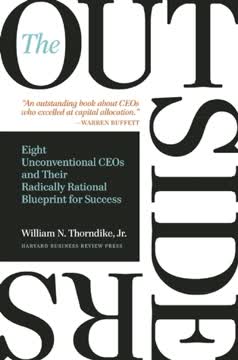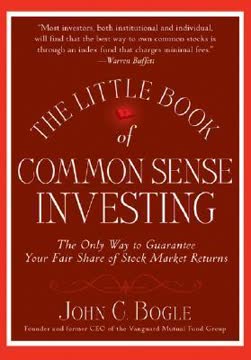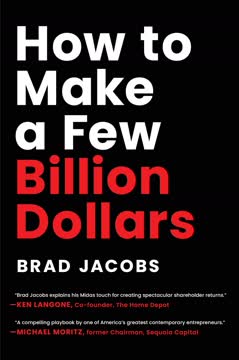Key Takeaways
1. Invest in Good Companies, Not Just Cheap Ones.
It’s far better to buy a wonderful company at a fair price than a fair company at a wonderful price.
Quality over price. The primary focus should be on identifying and investing in high-quality businesses, even if their shares aren't trading at rock-bottom valuations. While valuation matters, the long-term performance of a stock is more heavily determined by the underlying business's ability to generate strong returns and grow, rather than the initial purchase price. Chasing "cheap" stocks often means investing in poor businesses that destroy value over time.
Time is on your side. Good companies consistently create value for shareholders, meaning their intrinsic worth grows over time. This allows long-term investors to benefit from this compounding effect. In contrast, poor companies often destroy value, requiring investors to time market cycles or management changes perfectly to make a profit, a feat few can achieve consistently.
Avoid value traps. A stock may have a low valuation, but an even lower intrinsic value. Buying such a stock is not a recipe for investment success. While low-quality, cyclical stocks may have periods of outperformance, especially in economic recoveries, high-quality businesses have nothing to recover from and tend to outperform over longer periods.
2. Define "Good" by Financial Quality, Not Hype.
The primary test of managerial economic performance is the achievement of a high earnings rate on equity capital employed (without undue leverage, accounting gimmickry, etc.) and not the achievement of consistent gains in earnings per share.
Focus on ROCE. A truly good company is one that consistently achieves a high return on capital employed (ROCE), significantly exceeding its cost of capital. This metric, unlike simple earnings per share (EPS) growth, reveals whether a business is effectively using shareholder capital to generate profits and create value. High ROCE indicates efficient operations and strong competitive advantages.
Key financial characteristics. Look for businesses with:
- High gross and operating profit margins, indicating pricing power and cost control.
- Strong cash conversion, meaning profits are translated into real cash flow.
- Moderate debt levels and high interest cover, showing financial stability.
- A long history of resilience across economic cycles.
Beyond EPS. Companies can manipulate EPS through accounting adjustments, cost-cutting, or debt-funded buybacks without fundamentally improving the business. Focusing solely on EPS growth can be misleading and lead investors into value-destroying companies, as seen in examples like Tesco and IBM.
3. Compounding Power: Retained Earnings Drive Long-Term Value.
Over the long term, it’s hard for a stock to earn a much better return than the business which underlies it earns.
Magic of compounding. The unique advantage of equity investment is the ability of companies to retain a portion of their earnings and reinvest them back into the business. If these retained earnings are reinvested at a high rate of return (ROCE), the value of the business, and thus the share price, can compound dramatically over time. This effect is far more significant than the impact of reinvesting dividends.
Retained vs. reinvested dividends. Retained earnings are reinvested at the company's book value, while dividends, if reinvested by the shareholder, are used to buy shares at the market price (often a significant premium to book value). Furthermore, dividends are often taxed before they can be reinvested. This makes retained earnings a much more powerful engine for long-term value creation.
Berkshire Hathaway example. Warren Buffett's decision never to pay a dividend at Berkshire Hathaway, instead reinvesting all earnings, illustrates this principle perfectly. By reinvesting at superior rates of return, Berkshire has compounded value for shareholders far more effectively than if it had paid dividends, even if those dividends were reinvested by shareholders after tax.
4. Avoid Market Timing and Excessive Trading.
There are only two types of investors – those who know they can’t make money from market timing, and those who don’t know they can’t.
Futility of timing. Attempting to buy low and sell high by predicting market movements is incredibly difficult, if not impossible, for most investors and even professionals. Data shows that investors consistently buy after markets have risen and sell after they have fallen, doing the opposite of what is required for successful timing. Missing even a few of the best market days can severely damage long-term returns.
Inactivity is a virtue. Frequent dealing incurs significant costs, including commissions, bid-offer spreads, and taxes, which directly detract from investment performance. The average fund manager's high portfolio turnover (often 80% annually) adds substantial hidden costs on top of management fees.
Stick to the plan. Once you have invested in good companies at reasonable prices, the best strategy is often to "do nothing." Allow the power of compounding in the underlying businesses to work over the long term. Emotional reactions to short-term market volatility or commentary often lead to poor, mistimed decisions.
5. Minimize Costs: Fees and Dealing Eat Returns.
Fees paid to fund managers and advisers are a drag on investment performance.
Costs compound negatively. Every fee and transaction cost, no matter how small, reduces the net return on your investment. Over decades, these costs compound, significantly eroding the final value of your portfolio. Investors are often unaware of the total costs incurred, which include not just stated management fees but also hidden dealing costs.
Hidden transaction costs. Beyond the annual management charge (AMC) or ongoing charges figure (OCF), funds incur costs when buying and selling investments. These include broker commissions, the difference between buying and selling prices (bid-offer spread), and stamp duty. These costs are often not included in the OCF but can add significantly to the total cost of investment (TCI).
Cut out intermediaries. To minimize costs, reduce the layers of intermediaries between you and the actual investments. Investing directly where possible or using low-cost index funds are effective ways to keep costs down. Given that most active managers underperform their benchmarks anyway, paying high fees for active management that simply hugs the index is often a losing proposition.
6. Beware of Jargon, Accounting Tricks, and Financial Engineering.
I always think that if you can’t understand what an investment does, it is because you are not meant to understand.
Complexity hides problems. Be suspicious of investment products or company reports filled with jargon, euphemisms, or complex structures. If you don't understand it, don't invest in it. Companies often use "adjusted," "core," or "underlying" figures to flatter results by excluding recurring negative items, as seen with AstraZeneca's "core" earnings or Mondelez's numerous adjustments.
Focus on fundamentals. Don't be distracted by financial engineering aimed at boosting metrics like EPS or reported margins without improving the underlying business. Share buybacks, especially when debt-funded or done irrespective of valuation, can destroy value for remaining shareholders. Restructuring or splitting businesses based on activist demands may benefit short-term traders but harm long-term owners.
Read the accounts. Relying solely on management presentations or analyst summaries can be dangerous. Studying the actual financial statements (GAAP earnings, cash flow statements, balance sheets) is essential to uncover potential issues or understand the true financial health and performance of a company, bypassing misleading "adjusted" figures.
7. Focus on "Known Knowns," Ignore Macro Forecasts.
The only function of economic forecasting is to make astrology look respectable.
Macro is unknowable. Predicting macroeconomic events (GDP growth, interest rates, currency movements, political outcomes) is notoriously unreliable. Even if you could predict them, markets are second-order systems, meaning you would also need to know what the market expects and how it would react, adding another layer of impossible prediction.
Irrelevant to strategy. A sound investment strategy should not rely on forecasting macro events. Focus instead on factors you can analyze and understand: the quality of the underlying businesses you invest in and the price you pay for them. These are the "known knowns" that determine long-term investment success.
Avoid the noise. Market commentary is often dominated by speculation on macro events, creating "noise" that distracts from fundamental analysis. Ignore pundits who base investment advice on unpredictable events. Their track record of prediction is poor, and following their advice often leads to missed opportunities or mistimed decisions.
8. Most Stocks Fail; Outperformance is Concentrated.
Just over 4% of the companies account for all of the wealth created.
Few winners drive returns. Research shows that over long periods, the vast majority of individual stocks underperform even low-risk assets like Treasury bills. Equity index returns are skewed by the massive positive returns generated by a very small number of outlier companies.
Active management challenge. This concentration of returns explains why most active fund managers underperform. Even if they avoid the worst-performing stocks, they are unlikely to hold enough of the few truly exceptional winners to beat the index, especially after fees and costs.
Implications for investors. If you are not confident in your ability to identify the tiny percentage of companies that will generate significant long-term wealth, you are likely better off investing in a broad, low-cost index fund to capture the market's overall return, which is driven by those few winners. Successful active management requires identifying and holding these rare, high-quality compounders.
9. Question Conventional Wisdom: From Diversification to Income.
Nostalgia is not what it used to be. Neither, it seems, is investing in equities for income.
Diversification limits. While diversification is beneficial, its advantages diminish significantly after around 20-30 stocks. Over-diversifying ("diworsification") dilutes returns, makes it harder to know your holdings well, and forces you to compromise on quality by including less attractive businesses.
Income focus is misguided. The obsession with dividend income often leads investors to prioritize yield over total return. High-yielding stocks may have poor growth prospects or unsustainable payouts. The true driver of long-term equity returns is the reinvestment of retained earnings at high rates, not the distribution of dividends.
Total return matters. Investors, especially retirees, should focus on maximizing total return (capital appreciation plus dividends) and redeem units as needed for spending. This is often more tax-efficient and allows investment in companies that retain earnings for high-return reinvestment, which are unlikely to be high-yielders but offer better long-term growth.
10. Be Wary of Certain Products and Sectors.
If a fund which is described by the words “synthetic”, “derivative”, “swap” and “counterparty” does not cause you obvious concerns, I suggest you may need to study the events of the Credit Crisis of the past four years more carefully.
Avoid complexity and opacity. Be extremely cautious of investment products you don't fully understand, especially those involving derivatives, swaps, or complex structures like synthetic ETFs or precipice bonds. These vehicles often carry hidden risks and counterparty exposure that can lead to unexpected losses.
Problematic sectors. Certain sectors are inherently difficult for long-term, quality-focused investors due to structural issues or opacity. Examples include:
- Banks: High leverage, opaque balance sheets (derivatives), systemic risk.
- Airlines: Endemically poor returns on capital, value destruction.
- Pharmaceuticals: Reliance on "core" earnings excluding significant costs (R&D, M&A amortization), patent cliffs, trial failures.
- Retailers: Intense competition, capital intensity, often poor returns (e.g., Tesco).
Focus on predictability. Seek businesses with simple, predictable models based on everyday, repeat transactions, rather than those in volatile, opaque, or structurally challenged industries.
11. Management Matters, But Be Wary of Changes and Activism.
Never buy shares in companies which require a genius or charismatic chief executive to make them work.
Avoid reliance on individuals. While good management is important, avoid companies whose success seems solely dependent on a single charismatic leader. Sooner or later, that individual will leave, and the business's performance may suffer, as seen with Manchester United after Sir Alex Ferguson or Tesco after Sir Terry Leahy.
Be wary of activism. Shareholder activism often focuses on short-term share price boosts through financial engineering (debt-funded buybacks) or corporate actions (spin-offs, sales) that may not benefit long-term shareholders. Activists often use derivatives, indicating a short time horizon. Companies responding to activism by suddenly announcing new targets or buybacks may be prioritizing the activist over sound long-term strategy.
Assess management actions. Evaluate management based on their capital allocation decisions and whether they are reinvesting earnings at high rates of return. Be skeptical of management presentations using "adjusted" figures or announcing sudden strategic shifts in response to external pressure.
12. Invest Globally, Avoid Home Bias.
Similarly, as investors, we would do well to realise that our home market, the one with which we are most familiar, is not that important.
Global opportunity set. Limiting your investment universe to your home country significantly restricts your access to the world's best companies and growth opportunities. The global economy offers a much wider selection of high-quality businesses across diverse sectors.
Home bias is detrimental. The tendency for investors to overweight their domestic market ("home bias") is often driven by familiarity rather than rational analysis. This can lead to concentrated exposure to a single economy and miss out on superior returns available elsewhere.
Indices are not economies. Domestic indices like the FTSE 100 are often not representative of the home economy, with a large proportion of revenues generated internationally. Investing in such an index is already an international investment, but one limited to a specific, potentially suboptimal, basket of companies. A global mandate allows for investment in the best companies regardless of where they are listed or headquartered.
Last updated:
Review Summary
Investing for Growth receives mostly positive reviews for its clear investment philosophy: buy quality companies, don't overpay, and do nothing. Readers appreciate Smith's direct writing style and insights on return on capital employed. However, some criticize the book's repetitive nature, as it's a collection of articles and letters. Many find value in Smith's focus on long-term investing in high-quality businesses, though a few desire more detailed company analyses. Overall, it's recommended for both novice and experienced investors seeking a sound approach to sustainable wealth building.
Similar Books










Download PDF
Download EPUB
.epub digital book format is ideal for reading ebooks on phones, tablets, and e-readers.




